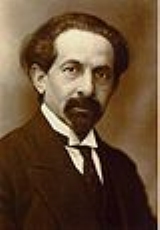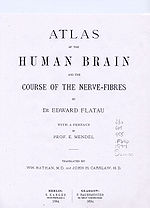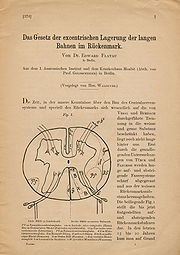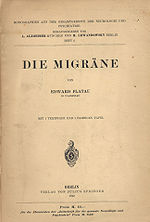
Edward Flatau
Encyclopedia
Edward Flatau was a Polish
neurologist
. His work greatly influenced the developing field of neurology. He established neurobiologic and neuropathological sciences in Poland
. He published a human brain atlas in 1894, wrote a fundamental book on migraine
s (1912), established the localization principle of long fibres in the spinal cord (1893), with Sterling (1911) published an early paper on progressive torsion spasm in children and suggested that the disease has a genetic component.
(1836–1902). Flatau became a medical doctor in 1892 and spent the years 1893 to 1899 in Berlin
in the laboratories of Emanuel Mendel
(1839–1907), Wilhelm von Waldeyer-Hartz
(1836–1921), Alfred Goldscheider
(1858–1935), and Ernst Viktor von Leyden
(1832–1910).

small diaphragms). In a review, Sigmund Freud
wrote: The plates with their clarity deserve to be called excellent educational material, suitable as an utterly reliable reference. A schematic plate in the beginning gives an overview of our knowledge on the fibre pathways in the CNS, incorporating the accounts of Mendel, Bechterew and Edinger and continuing with the differing views on the structure of nervous tissue of Golgi
and Ramo´n y Cajal
. The price of the work is minimal if one considers its completeness and beauty. The author and publisher deserve thanks from the medical community for this valuable work.

he performed experimental work on dogs and criticised Bastian-Bruns Law concerning the loss of function following spinal cord injury (1893).
On the basis of numerous clinical spinal cord surgeries, experiments and subsequent observations, he discovered that the "greater the length of the fibres in the spinal cord the closer they are situated to the periphery" (Flatau's Law). He provided evidence for the laminar arrangement of spinal pathways.
. He also described the fifth, seventh and eighth cranial nerves, and carefully outlined their nuclei. The paper on this topic Das Gesetz der excentrischen Lagerung der langen Bahnen im Rückenmark was published in 1897. For this work he received a Ph.D. in medical sciences in Moscow in 1899 (dissertation "Zakon ekscentriczeskago raspolozenia dlinnych putiej w spinnom mózgu").
recently developed by Ramón y Cajal
and Waldeyer
and became one of its proponents. In several publications he tried to establish a unity between the physiology and anatomy of the neuron. Together with Alfred Goldscheider
he worked on the structure of nerve cells and their changes under mechanical, thermal and toxic influences. They published results of their experiments in 1897 and 1898 in Fortschritte der Medizin and Gazeta Lekarska which were subsequently published as a special monograph. They state that the character of changes in neuron cells could provide information about the type of influences acting on them. This work, in which the normal and pathologic anatomy of the Vth, VIIth and VIIIth (cochlear) cranial nerves was included, created much discussion and was adversely criticized by Nissl
, who opposed the neuron theory.
In 1927 Flatau, independently of Emil Redlich in Vienna, described the first cases of encephalomyelitis epidemica disseminata (Flatau-Redlich disease). Flatau was convinced that this illness is caused by a virus which was latter confirmed by Mergulis. Flatau described in detail Schilder disease and introduced its name encephalitis periaxialis diffusa.

s. This book was reprinted in 2007, 95 years after its original publication, and is still frequently referenced in scientific literature. In a review of the historical background of general aspects of the headaches, Isler and Rose say, "His unique monograph of 1912, Die Migrane, contains a thorougly structured survey of most earlier authors, precise clinical observations, a critical evaluation of pathophysiology, and uncritical opinions on treatment, including arsenic cures."
. In 1904 he became head of neurology in "Na Czystem" Hospital in Warsaw.
For many years he shared his responsibilities as experimentalist and neurologist between the laboratory and the hospital. He also had a large private practice. He was influential in establishing Polish medical periodicals "Neurologia Polska" and "Warszawskie Czasopismo Lekarskie". He supported the establishment of the Neurological and Psychiatry Section of the Warsaw Medical Society, and had many outstanding students.
He died in 1932, the same year as two other notable Polish neurologists; Samuel Goldflam
and Joseph Jules François Félix Babinski
(Polish-French neurologist). He was married twice and had two daughters. One of his daughters was the Polish psychiatrist Joanna Flatau
.
Poland
Poland , officially the Republic of Poland , is a country in Central Europe bordered by Germany to the west; the Czech Republic and Slovakia to the south; Ukraine, Belarus and Lithuania to the east; and the Baltic Sea and Kaliningrad Oblast, a Russian exclave, to the north...
neurologist
Neurology
Neurology is a medical specialty dealing with disorders of the nervous system. Specifically, it deals with the diagnosis and treatment of all categories of disease involving the central, peripheral, and autonomic nervous systems, including their coverings, blood vessels, and all effector tissue,...
. His work greatly influenced the developing field of neurology. He established neurobiologic and neuropathological sciences in Poland
Poland
Poland , officially the Republic of Poland , is a country in Central Europe bordered by Germany to the west; the Czech Republic and Slovakia to the south; Ukraine, Belarus and Lithuania to the east; and the Baltic Sea and Kaliningrad Oblast, a Russian exclave, to the north...
. He published a human brain atlas in 1894, wrote a fundamental book on migraine
Migraine
Migraine is a chronic neurological disorder characterized by moderate to severe headaches, and nausea...
s (1912), established the localization principle of long fibres in the spinal cord (1893), with Sterling (1911) published an early paper on progressive torsion spasm in children and suggested that the disease has a genetic component.
Education
He went to medical school at the University of Moscow from 1886, being greatly influenced by the psychiatrist Sergei Sergeievich Korsakoff (1854–1900) and the neurologist Alexis Jakovlevich KozhevnikofAleksei Kozhevnikov
Aleksei Yakovlevich Kozhevnikov was a Russian neurologist and psychiatrist who was a native of Ryazan.From 1853 until 1858 he studied medicine at the University of Moscow, and furthered his education in Germany, Switzerland, England and France...
(1836–1902). Flatau became a medical doctor in 1892 and spent the years 1893 to 1899 in Berlin
Berlin
Berlin is the capital city of Germany and is one of the 16 states of Germany. With a population of 3.45 million people, Berlin is Germany's largest city. It is the second most populous city proper and the seventh most populous urban area in the European Union...
in the laboratories of Emanuel Mendel
Emanuel Mendel
Emanuel Mendel was a German neurologist and psychiatrist who was a university professor and director of a polyclinic in Berlin. He was born in Bunzlau, Lower Silesia; ....
(1839–1907), Wilhelm von Waldeyer-Hartz
Heinrich Wilhelm Gottfried von Waldeyer-Hartz
Heinrich Wilhelm Gottfried von Waldeyer-Hartz was a German anatomist, famous for consolidating the neuron theory of organization of the nervous system and for naming the chromosome...
(1836–1921), Alfred Goldscheider
Alfred Goldscheider
Johannes Karl Eugen Alfred Goldscheider was a German neurologist who was born in Sommerfeld ....
(1858–1935), and Ernst Viktor von Leyden
Ernst Viktor von Leyden
Ernst Viktor von Leyden was a German internist from Danzig.Leyden studied medicine at the Friedrich-Wilhelms-Institut in Berlin, and was a pupil of Johann Lukas Schönlein and Ludwig Traube . He was a medical professor at several universities, including Königsberg, Strassburg and Berlin...
(1832–1910).
Life and work

Brain atlas and spinal cord
In 1894, at the age of 25 he wrote the influential Atlas of the human brain and the course of the nerve-fibres, which was published in German, English, French, Russian, and in 1896 in Polish, based on long-exposure photographs of fresh brain sections (up to 10 minutes for flat and 30 minutes for uneven surfaces, by means ofsmall diaphragms). In a review, Sigmund Freud
Sigmund Freud
Sigmund Freud , born Sigismund Schlomo Freud , was an Austrian neurologist who founded the discipline of psychoanalysis...
wrote: The plates with their clarity deserve to be called excellent educational material, suitable as an utterly reliable reference. A schematic plate in the beginning gives an overview of our knowledge on the fibre pathways in the CNS, incorporating the accounts of Mendel, Bechterew and Edinger and continuing with the differing views on the structure of nervous tissue of Golgi
Camillo Golgi
Camillo Golgi was an Italian physician, pathologist, scientist, and Nobel laureate.-Biography:Camillo Golgi was born in the village of Corteno, Lombardy, then part of the Austrian Empire. The village is now named Corteno Golgi in his honour. His father was a physician and district medical officer...
and Ramo´n y Cajal
Santiago Ramón y Cajal
Santiago Ramón y Cajal ForMemRS was a Spanish pathologist, histologist, neuroscientist, and Nobel laureate. His pioneering investigations of the microscopic structure of the brain were original: he is considered by many to be the father of modern neuroscience...
. The price of the work is minimal if one considers its completeness and beauty. The author and publisher deserve thanks from the medical community for this valuable work.

Flatau's Law
With the Berlin neurobiologist Johannes GadJohannes Gad
Johannes Wilhelm Gad was a German neurophysiologist who was a native of Posen.He was an assistant to Emil du Bois-Reymond at the physiological institute at the University of Berlin, and later worked under Adolf Fick at the University of Würzburg...
he performed experimental work on dogs and criticised Bastian-Bruns Law concerning the loss of function following spinal cord injury (1893).
On the basis of numerous clinical spinal cord surgeries, experiments and subsequent observations, he discovered that the "greater the length of the fibres in the spinal cord the closer they are situated to the periphery" (Flatau's Law). He provided evidence for the laminar arrangement of spinal pathways.
. He also described the fifth, seventh and eighth cranial nerves, and carefully outlined their nuclei. The paper on this topic Das Gesetz der excentrischen Lagerung der langen Bahnen im Rückenmark was published in 1897. For this work he received a Ph.D. in medical sciences in Moscow in 1899 (dissertation "Zakon ekscentriczeskago raspolozenia dlinnych putiej w spinnom mózgu").
Early proponent of neuron theory
In 1895 Flatau became interested in neuron theoryNeuron doctrine
The neuron doctrine is a descriptive term for the fundamental concept that the nervous system is made up of discrete individual cells, a discovery due to decisive neuro-anatomical work of Santiago Ramon y Cajal and later presented, among others, by H. Waldeyer-Hartz...
recently developed by Ramón y Cajal
Santiago Ramón y Cajal
Santiago Ramón y Cajal ForMemRS was a Spanish pathologist, histologist, neuroscientist, and Nobel laureate. His pioneering investigations of the microscopic structure of the brain were original: he is considered by many to be the father of modern neuroscience...
and Waldeyer
Heinrich Wilhelm Gottfried von Waldeyer-Hartz
Heinrich Wilhelm Gottfried von Waldeyer-Hartz was a German anatomist, famous for consolidating the neuron theory of organization of the nervous system and for naming the chromosome...
and became one of its proponents. In several publications he tried to establish a unity between the physiology and anatomy of the neuron. Together with Alfred Goldscheider
Alfred Goldscheider
Johannes Karl Eugen Alfred Goldscheider was a German neurologist who was born in Sommerfeld ....
he worked on the structure of nerve cells and their changes under mechanical, thermal and toxic influences. They published results of their experiments in 1897 and 1898 in Fortschritte der Medizin and Gazeta Lekarska which were subsequently published as a special monograph. They state that the character of changes in neuron cells could provide information about the type of influences acting on them. This work, in which the normal and pathologic anatomy of the Vth, VIIth and VIIIth (cochlear) cranial nerves was included, created much discussion and was adversely criticized by Nissl
Franz Nissl
Franz Nissl was a German medical researcher. He was a noted neuropathologist.-Early life:...
, who opposed the neuron theory.
Neurology and early human genetics
Flatau and Wladyslaw Sterling in 1911 published an early paper on progressive torsion spasm in children the same year as Ziehen and Oppenheim. Unlike Oppenheim's this paper suggested that the disease has a genetic component.In 1927 Flatau, independently of Emil Redlich in Vienna, described the first cases of encephalomyelitis epidemica disseminata (Flatau-Redlich disease). Flatau was convinced that this illness is caused by a virus which was latter confirmed by Mergulis. Flatau described in detail Schilder disease and introduced its name encephalitis periaxialis diffusa.

Migraine and headaches
In 1912 he published in German and Polish the first modern monograph about migraineMigraine
Migraine is a chronic neurological disorder characterized by moderate to severe headaches, and nausea...
s. This book was reprinted in 2007, 95 years after its original publication, and is still frequently referenced in scientific literature. In a review of the historical background of general aspects of the headaches, Isler and Rose say, "His unique monograph of 1912, Die Migrane, contains a thorougly structured survey of most earlier authors, precise clinical observations, a critical evaluation of pathophysiology, and uncritical opinions on treatment, including arsenic cures."
Contribution to Polish science
By 1899 Flatau had established a name for himself both in Germany and abroad and returned to Poland during that year. Flatau was closely associated with attempts to re-establish Polish science during and after Russian occupation. After his return he formed a private microscopy laboratory at his apartments in Warsaw and worked in Warsaw hospitals as a consultant. In 1911 he established a neurological laboratory in the Warsaw Psychologic Society and he became in 1913 the first head of the Department of Neurobiology of the Warsaw Scientific Society (Warszawskie Towarzystwo Naukowe) and from 1911 to 1923 head of the department of Neurobiology at the Nencki Institute of Experimental BiologyNencki Institute of Experimental Biology
The Nencki Institute of Experimental Biology is a scientific research organization headquartered in Warsaw.- Early history :It was founded in 1918/19, shortly after the reestablishment of Poland as an independent country...
. In 1904 he became head of neurology in "Na Czystem" Hospital in Warsaw.
For many years he shared his responsibilities as experimentalist and neurologist between the laboratory and the hospital. He also had a large private practice. He was influential in establishing Polish medical periodicals "Neurologia Polska" and "Warszawskie Czasopismo Lekarskie". He supported the establishment of the Neurological and Psychiatry Section of the Warsaw Medical Society, and had many outstanding students.
He died in 1932, the same year as two other notable Polish neurologists; Samuel Goldflam
Samuel Goldflam
Samuel Wulfowicz Goldflam was a Polish neurologist best known for his brilliant 1893 analysis of myasthenia gravis .-Life:...
and Joseph Jules François Félix Babinski
Joseph Babinski
Joseph Jules François Félix Babinski was a French neurologist of Polish descent. He is best known for his 1896 description of the Babinski sign, a pathological plantar reflex indicative of corticospinal tract damage....
(Polish-French neurologist). He was married twice and had two daughters. One of his daughters was the Polish psychiatrist Joanna Flatau
Joanna Flatau
Joanna Antonina Flatau was a Polish psychiatrist. She developed innovative techniques for treating nervous disorders and established psychiatry services for Warsaw students. .-Life:...
.

